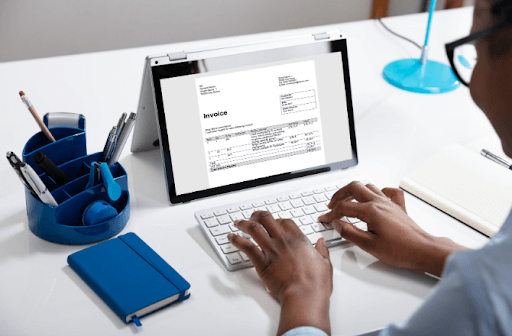Should You Require Payment Upon Receipt? [B2B Guide]
As a small business owner, making sure that you get paid in time to settle your own bills can seem like a constant struggle.
It would be nice to have a simple exchange of payment for services as soon as you hand your client an invoice.
If that is truly what you need, you can always use “due upon receipt” invoicing as a solution.
There are times when this type of invoicing is a smart move, but this isn’t always the case.
Let’s talk about when — and when not — to make payments due upon receipt.
What Does “Due Upon Receipt” Mean?
The payment terms “due upon receipt” mean that you expect your client to pay as soon as they receive the invoice.
Instead of asking them to pay within 14 or 30 days on your invoice, you’re letting them know that you expect payment by the next business day.
As already mentioned, this type of invoicing can be beneficial, but it also has some drawbacks. Let’s discuss these positives and negatives.
Advantages to Due Upon Receipt Invoicing
There are three main advantages to due upon receipt invoicing:
Better Cash Flow
This strategy can speed up invoice payments.
The earlier you get paid, the better your cash flow will be. When you ask for payment upon receipt, you recoup your money faster. It shortens the time between when you paid for expenses and when you make your money back.
This quicker inflow of cash allows for more production by providing money to invest back into the business.
It’s worth mentioning as well that as a small business, you rely on this income to pay your payroll, electricity, insurance, and more.
Especially if you are in the beginning stages of building your business, due upon receipt invoicing can make it possible to stay in business until you get established.
Time Management
Small businesses are often built upon hard work, sweat, and innovation. Many times there are individuals who are doing the work of three. Effective time management is crucial to the success of a small business.
With due upon receipt invoicing you can save a lot of time.
No more wasting time:
- Sending payment reminders
- Making phone calls to collect on unpaid invoices
- Perusing through your books to find out who has and who hasn’t paid
Using the “work smarter, not harder” mentality, due upon receipt invoicing definitely falls into the smarter category.
With this type of payment terms, you don’t have to waste your efforts to track down the payment every week or two.
More Efficient
Along the same lines, small business owners need to have laser focus to stay on top of everything.
Why not take one of those worries off your plate?
Getting paid immediately helps to free up your mind to take care of the other business tasks. You’ll be able to have better focus and less worry when you use due upon receipt invoicing.
Sometimes, the fault of unpaid invoices falls upon the business and not the client simply because they get forgotten or lost in the pile of other papers and memos.
With due upon receipt, you won’t forget about unpaid invoices and possibly lose money. You’ll get that money before your mind — and time — fill up with other responsibilities.
Do you know the difference between Net Profit vs. Gross Profit?
Disadvantages to Due Upon Receipt Invoicing
With all the above advantages, you may be wondering why doesn’t everyone adopt this technique?
Due upon receipt may seem like the solution to all your cash flow worries, but it isn’t ideal for every situation.
Read on to better understand why.
Not for Everyone
Small businesses should understand the woes of paying invoices right away. Many of your clients may be small businesses themselves.
It may not be within their means to pay immediately. Because they need to turn around and deliver goods to their client and wait for their payment, just as you are doing with them.
If you can’t budge on the payment terms to allow them to collect the capital they need to pay you, you are making it impossible to continue business with you.
Doesn’t Allow for Client Reviews
Some clients prefer to take time to review your work or assess the value of your goods before paying their invoices.
This is especially true if you are a freelancer. The client relationship of a freelancer often allows for review and requested modifications before making a payment.
If you stand by your work, your payment terms should prove that you are confident that they will be pleased with it as well.
Due upon receipt invoicing doesn’t give your client enough time to inspect or experience your products or services before paying in full.
Can Sound Pushy
For any business, client relationships are just as crucial to your business as client payments. If you don’t have a good relationship with your clients, you will lose their business. It’s just a matter of time.
For this reason, some small business owners would rather wait a little longer to receive their payments. Rather than take their chances by expecting payment upfront.
Due upon receipt payment terms may strain some client relationships.
Are the advantages of this type of invoicing worth the risk?
Should You Use a Due Upon Receipt Payment Term?
Now that you know the pros and cons of due upon receipt invoicing, you may be wondering how and when to use this in your business.
It is best to make the decision of payment terms on a client-by-client basis.
The ideal payment terms and whether to expect payment right away is dependent on the client.
How much history you have and how much future you foresee with them is a significant determining factor.
It may be a good idea to make the payment due right away for new clients until you trust them enough to allow for some leeway. You might also do it if a client has a history of late or short payments but you want to continue working with them.
If you consider the exchange a one-and-done deal, you could benefit from using a due upon receipt invoice. For a one-time client, you wouldn’t risk anything by requesting that they pay right away.
The type of client relationship you have with this person or business should direct your decision.
If you’ve already established a good rapport with them and vice versa, making a little leeway for them to pay would be wise. You will only be cultivating an even stronger client relationship.
If you are dealing with this individual or business for the first or last time, you may want to secure payment as soon as possible. Of course, even this situation needs examining before making that decision.
If you are hoping for repeat business from a client, due upon receipt may not be the best option.
How to Word a Due Upon Receipt Request
It could be that you would like to use the due upon receipt invoicing terms for a particular client. But you don’t want to just stamp it in big red letters on the invoice.
When requesting to receive payment upon receipt, you should strive to use the most respectful wording possible.
To ensure that the exchange goes smoothly, the client should be well aware of the payment terms.
Write when and how you expect payment in clear language on the contract before you begin work or deliver goods.
As always, be polite and grateful for their business, even if it’s a one-time job.
If you fail to notify the client of these terms, the unexpected payment terms could leave a sour taste in their mouth, and you could lose a customer.
Even if they wouldn’t mind paying within 24 hours, they might not appreciate the surprise of this expectation.
It makes the business transaction easier to have everyone fully informed from the beginning.
To do so tactfully, you may want to use some unique language other than simply writing “due upon receipt.” You can get that message across without using those exact words.
Check out these examples of how to get your invoice payment terms across in less harsh language.
Alternatives to Due Upon Receipt
When you decide that “due upon receipt” isn’t the right fit for this transaction, you have some alternatives to use that can still define a payment period.
Obviously, you want to receive payment in a timely fashion, and your client deserves to know when you expect them to pay.
Here are some of the popular ways to ensure your cash flow doesn’t come to a standstill.
Net “D”
The Net D payment method is an adjustable payment method. The “D” stands for the number of days, and you can use whatever number you want to fit the payment expectations.
For example, Net 7 means that payment is due in a week, Net 30 means that payment is due in 30 days, etc.
The beauty of these terms of payment is that you can adjust them to fit your business and your client.
However, keeping a standard payment term keeps things simple to track. It may be frustrating to remember who you have on a Net 30 payment term and with who you use a Net 60.
You wouldn’t want to accidentally send an overdue notice from a Net 60 client before the due date because you confused them with a Net 30.
Improve Payment Convenience
One of the best ways to increase your chances of getting quick payments is by making it easy for your client to pay the bill.
One way to do that is to accept several methods of payment. Most small businesses now accept credit cards, but technology has taken the world of payment methods even further.
Creating an online payment gateway allows your customer to log in to pay directly from their bank account. They can also keep track of their history and total amount due, which can help them stay on top of their payments.
Accepting digital payments such as Paypal, Cashapp, and Venmo takes this another step further. There are plenty of payment methods to be aware of, and the more you accept, the better.
Generally, when you make it as convenient as possible for your client to pay, you will get fewer late payments.
Of course, there are advantages and disadvantages to some of these methods. Learn more about small business payment methods here.
Provide Early Payment Incentive
Getting paid earlier could be as simple as providing your client with the right incentive.
You can then let them decide whether to take advantage of these incentives or not and take all the heat off of you.
There are two types of payment incentives, fees or discounts. Both incentives save your clients money if they pay early.
Adding late fees to your invoice after a specific date allows the client a window of opportunity to pay before accruing any fees.
By offering an early payment discount, you are, in effect, rewarding your client for paying in a timely fashion.
Invoice Acceleration Solutions
Cash flow restrictions and invoice management are not new problems that small businesses face. In fact, they’re some of the biggest problems.
To provide a way to fill the need, the development of invoice acceleration solutions came to fruition.
Invoice acceleration solutions are the use of a “middle man” company. They will, in effect, “buy” your invoice from you for a small fee and, in turn, collect it from your client.
With this service, you get paid almost as fast as “due upon receipt” invoicing. You will benefit from all the pros of “due upon receipt” payment terms without any cons.
Related reading: SMB Guide to Invoice Factoring.
Due upon receipt invoicing is a viable option for any small business to ensure that they get paid as soon as possible. However, proper usage of due upon receipt invoice payment terms is an integral part of its success.
When situations arise that you need the cash now but delivering a due upon receipt invoice isn’t an option, Now can help.
Get invoices paid quickly while maintaining strong client relationships with Now’s invoice acceleration services.






